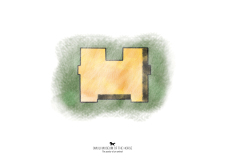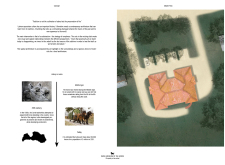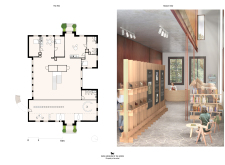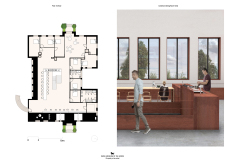5 key facts about this project
The design emphasizes a concept centered around the idea of “substraction,” which manifests through carefully planned voids that redefine spatial relationships within the building. These voids encourage exploration and enhance visitor interaction, promoting an ongoing dialogue between the exhibits and the surrounding landscape. The layout incorporates open spaces that facilitate movement and social engagement, establishing a connection between the internal activities of the museum and the natural environment.
Materiality and Structural Approach
The selection of materials plays a crucial role in the architectural identity of the Omuli Museum. Predominantly featuring wood, steel, concrete, and brick, the materials reflect local craftsmanship and the historical significance of equestrian culture in Latvia. The use of wood creates a warm and inviting atmosphere, while steel engages in structural elements, providing integrity and a modern aesthetic. Concrete is utilized strategically, enhancing the sense of openness created by the spatial cuts, and brick is incorporated to connect the design to traditional building techniques.
The museum's design includes distinct areas such as a spacious foyer that serves as a central hub, leading to exhibition spaces and visitor amenities. The first floor is designed with large windows that allow ample natural light, enhancing the exhibit experience. Common areas encourage social interaction, making them essential for visitor engagement. Each interior space is carefully curated, balancing comfort and functionality while maintaining a clear focus on the museum's mission to educate about equestrian history.
Unique Design Approach and Integration with Nature
What sets the Omuli Museum apart from other architectural projects is its unique integration with the natural landscape. The design approach does not solely focus on the built environment; it considers the surrounding terrain and its historical significance. The strategic placement of the building respects the existing landscape, allowing visitors to experience both architecture and nature harmoniously. This not only enhances the aesthetic appeal but also reinforces the museum's connection to equestrian culture.
Additionally, the fluidity of the exhibition spaces allows for adaptability in programming. This flexibility fosters a diverse range of educational opportunities and events, enabling the museum to serve as a community resource beyond traditional gallery functions.
To explore the architectural plans, sections, designs, and other architectural ideas related to the Omuli Museum of the Horse, readers are encouraged to engage with the project presentation for more in-depth insights. This exploration will offer a comprehensive understanding of the museum's architectural significance and its role in preserving Latvia’s rich equestrian heritage.


























